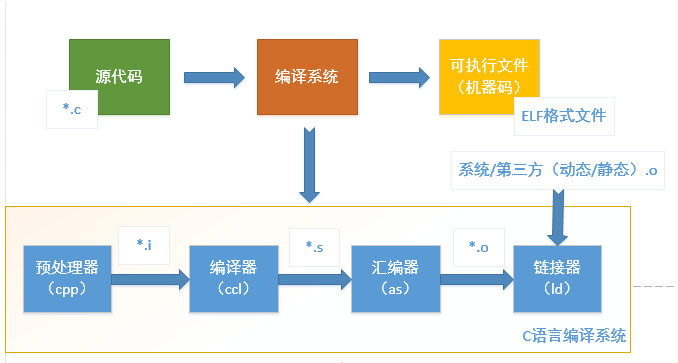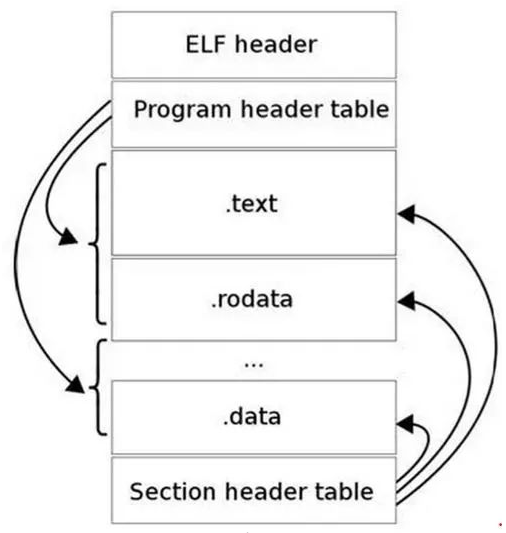
Computer programming languages are usually divided into three categories: machine language, assembly language and high-level language. High-level languages need to be translated into machine language before they can be executed. There are two ways of translation, one is compiled and the other is interpreted.
So we basically divide high-level languages into two categories, one is compiled language, such as C, C, Java, and the other is interpreted language, such as Python, Ruby, MATLAB, JavaScript.
This article will introduce the process of converting high-level programs written in C/C language into binary codes that can be executed by the processor, including four steps:

The commonly referred to as GCC is the abbreviation of GUN Compiler Collection, which is a commonly used compilation tool on Linux systems. GCC tool chain software includes GCC, Binutils, C runtime library, etc.
GCC (GNU C Compiler) is a compilation tool. This article will introduce the process of converting a program written in C/C language into a binary code that can be executed by the processor, which is completed by the compiler.
A set of binary program processing tools, including: addr2line, ar, objcopy, objdump, as, ld, ldd, readelf, size, etc. This set of tools is indispensable for development and debugging. Their respective introductions are as follows:
The C language standard mainly consists of two parts: one part describes the syntax of C, and the other part describes the C standard library. The C standard library defines a set of standard header files. Each header file contains some related functions, variables, type declarations and macro definitions. For example, the common printf function is a C standard library function, and its prototype is defined in the stdio header file.
C语言标准仅仅定义了C标准库函数原型,并没有提供实现。因此,C语言编译器通常需要一个C运行时库(C Run Time Libray,CRT)的支持。C运行时库又常简称为C运行库。与C语言类似,C++也定义了自己的标准,同时提供相关支持库,称为C++运行时库。
由于GCC工具链主要是在Linux环境中进行使用,因此本文也将以Linux系统作为工作环境。为了能够演示编译的整个过程,本节先准备一个C语言编写的简单Hello程序作为示例,其源代码如下所示:
#include
//此程序很简单,仅仅打印一个Hello World的字符串。
int main(void)
{
printf("Hello World! \n");
return 0;
}
“
预处理的过程主要包括以下过程:
使用gcc进行预处理的命令如下:
$ gcc -E hello.c -o hello.i // 将源文件hello.c文件预处理生成hello.i // GCC的选项-E使GCC在进行完预处理后即停止
hello.i文件可以作为普通文本文件打开进行查看,其代码片段如下所示:
// hello.i代码片段
extern void funlockfile (FILE *__stream) __attribute__ ((__nothrow__ , __leaf__));
# 942 "/usr/include/stdio.h" 3 4
# 2 "hello.c" 2
# 3 "hello.c"
int
main(void)
{
printf("Hello World!" "\n");
return 0;
}
编译过程就是对预处理完的文件进行一系列的词法分析,语法分析,语义分析及优化后生成相应的汇编代码。
使用gcc进行编译的命令如下:
$ gcc -S hello.i -o hello.s // 将预处理生成的hello.i文件编译生成汇编程序hello.s // GCC的选项-S使GCC在执行完编译后停止,生成汇编程序
上述命令生成的汇编程序hello.s的代码片段如下所示,其全部为汇编代码。
// hello.s代码片段 main: .LFB0: .cfi_startproc pushq %rbp .cfi_def_cfa_offset 16 .cfi_offset 6, -16 movq %rsp, %rbp .cfi_def_cfa_register 6 movl $.LC0, %edi call puts movl $0, %eax popq %rbp .cfi_def_cfa 7, 8 ret .cfi_endproc
汇编过程调用对汇编代码进行处理,生成处理器能识别的指令,保存在后缀为.o的目标文件中。由于每一个汇编语句几乎都对应一条处理器指令,因此,汇编相对于编译过程比较简单,通过调用Binutils中的汇编器as根据汇编指令和处理器指令的对照表一一翻译即可。
当程序由多个源代码文件构成时,每个文件都要先完成汇编工作,生成.o目标文件后,才能进入下一步的链接工作。注意:目标文件已经是最终程序的某一部分了,但是在链接之前还不能执行。
使用gcc进行汇编的命令如下:
$ gcc -c hello.s -o hello.o // 将编译生成的hello.s文件汇编生成目标文件hello.o // GCC的选项-c使GCC在执行完汇编后停止,生成目标文件 //或者直接调用as进行汇编 $ as -c hello.s -o hello.o //使用Binutils中的as将hello.s文件汇编生成目标文件
注意:hello.o目标文件为ELF(Executable and Linkable Format)格式的可重定向文件。
链接也分为静态链接和动态链接,其要点如下:
由于链接动态库和静态库的路径可能有重合,所以如果在路径中有同名的静态库文件和动态库文件,比如libtest.a和libtest.so,gcc链接时默认优先选择动态库,会链接libtest.so,如果要让gcc选择链接libtest.a则可以指定gcc选项-static,该选项会强制使用静态库进行链接。以Hello World为例:
$ gcc hello.c -o hello $ size hello //使用size查看大小 text data bss dec hex filename 1183 552 8 1743 6cf hello $ ldd hello //可以看出该可执行文件链接了很多其他动态库,主要是Linux的glibc动态库 linux-vdso.so.1 => (0x00007fffefd7c000) libc.so.6 => /lib/x86_64-linux-gnu/libc.so.6 (0x00007fadcdd82000) /lib64/ld-linux-x86-64.so.2 (0x00007fadce14c000)
如果使用命令“gcc -static hello.c -o hello”则会使用静态库进行链接,生成的ELF可执行文件的大小(使用Binutils的size命令查看)和链接的动态库(使用Binutils的ldd命令查看)如下所示:
$ gcc -static hello.c -o hello $ size hello //使用size查看大小 text data bss dec hex filename 823726 7284 6360 837370 cc6fa hello //可以看出text的代码尺寸变得极大 $ ldd hello not a dynamic executable //说明没有链接动态库
链接器链接后生成的最终文件为ELF格式可执行文件,一个ELF可执行文件通常被链接为不同的段,常见的段譬如.text、.data、.rodata、.bss等段。
ELF文件格式如下图所示,位于ELF Header和Section Header Table之间的都是段(Section)。一个典型的ELF文件包含下面几个段:

可以使用readelf -S查看其各个section的信息如下
$ readelf -S hello There are 31 section headers, starting at offset 0x19d8: Section Headers: [Nr] Name Type Address Offset Size EntSize Flags Link Info Align [ 0] NULL 0000000000000000 00000000 0000000000000000 0000000000000000 0 0 0 …… [11] .init PROGBITS 00000000004003c8 000003c8 000000000000001a 0000000000000000 AX 0 0 4 …… [14] .text PROGBITS 0000000000400430 00000430 0000000000000182 0000000000000000 AX 0 0 16 [15] .fini PROGBITS 00000000004005b4 000005b4 ……
由于ELF文件无法被当做普通文本文件打开,如果希望直接查看一个ELF文件包含的指令和数据,需要使用反汇编的方法。
使用objdump -D对其进行反汇编如下:
$ objdump -D hello …… 0000000000400526 : // main标签的PC地址 //PC地址:指令编码 指令的汇编格式 400526: 55 push %rbp 400527: 48 89 e5 mov %rsp,%rbp 40052a: bf c4 05 40 00 mov $0x4005c4,%edi 40052f: e8 cc fe ff ff callq 400400 400534: b8 00 00 00 00 mov $0x0,%eax 400539: 5d pop %rbp 40053a: c3 retq 40053b: 0f 1f 44 00 00 nopl 0x0(%rax,%rax,1)
使用objdump -S将其反汇编并且将其C语言源代码混合显示出来:
$ gcc -o hello -g hello.c //要加上-g选项
$ objdump -S hello
……
0000000000400526 :
#include
int
main(void)
{
400526: 55 push %rbp
400527: 48 89 e5 mov %rsp,%rbp
printf("Hello World!" "\n");
40052a: bf c4 05 40 00 mov $0x4005c4,%edi
40052f: e8 cc fe ff ff callq 400400
return 0;
400534: b8 00 00 00 00 mov $0x0,%eax
}
400539: 5d pop %rbp
40053a: c3 retq
40053b: 0f 1f 44 00 00 nopl 0x0(%rax,%rax,1)
……
The above is the detailed content of Detailed explanation of Linux program compilation process. For more information, please follow other related articles on the PHP Chinese website!




